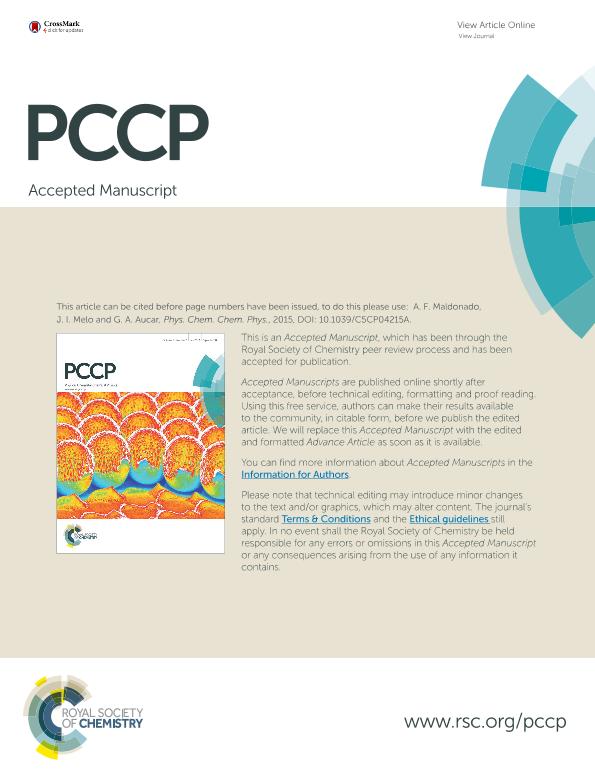Mostrar el registro sencillo del ítem
dc.contributor.author
Maldonado, Alejandro Fabián

dc.contributor.author
Melo, Juan Ignacio

dc.contributor.author
Aucar, Gustavo Adolfo

dc.date.available
2017-08-07T19:15:50Z
dc.date.issued
2015-09
dc.identifier.citation
Maldonado, Alejandro Fabián; Melo, Juan Ignacio; Aucar, Gustavo Adolfo; Theoretical analysis of NMR shieldings of group-11 metal halides on MX (M = Cu, Ag, Au; X = H, F, Cl, Br, I) molecular systems, and the appearance of quasi instabilities on AuF; Royal Society of Chemistry; Physical Chemistry Chemical Physics; 38; 17; 9-2015; 25516-25524
dc.identifier.issn
1463-9076
dc.identifier.uri
http://hdl.handle.net/11336/21976
dc.description.abstract
Accurate calculations of nuclear magnetic shieldings of group-11 metal halides, σ(M; MX) (M = Cu, Ag, Au; X = H, F, Cl, Br, I), were performed with relativistic and nonrelativistic theoretical schemes in order to learn more about the importance of the involved electronic mechanisms that underlie such shieldings. We applied state of the art schemes: polarization propagators at a random phase level of approach (PP-RPA); spin-free Hamiltonian (SF); linear response elimination of small component (LRESC) and density functional theory (DFT) with two different functionals: B3LYP and PBE0. The results from DFT calculations are not close to those from the relativistic polarization propagator calculations at the RPA level of approach (RelPP-RPA), in line with previous results. The spin–orbit (SO) contribution to a shielding constant is important only for MF molecules (M = Cu, Ag, Au). Different electronic mechanisms are considered within the LRESC method, bunched into two groups: core- and ligand-dependent. For the analysed shieldings the core-dependent electronic mechanisms are the most important ones; the ligand-dependent being only important for MF molecules. An out of range value for σ(Au) is found in AuF. It was previously reported in the literature, either originated in the large fluorine electronegativity together with large spin–orbit coupling contributions; or, due to Fermi-contact contributions. We argue here that such an unexpected large value is an artifact originated in the appearance of quasi instabilities, and show how to handle this apparent problem.
dc.format
application/pdf
dc.language.iso
eng
dc.publisher
Royal Society of Chemistry

dc.rights
info:eu-repo/semantics/openAccess
dc.rights.uri
https://creativecommons.org/licenses/by/2.5/ar/
dc.subject
Metal Halides
dc.subject
Auf
dc.subject
Nmr
dc.subject
Lresc
dc.subject.classification
Otras Ciencias Físicas

dc.subject.classification
Ciencias Físicas

dc.subject.classification
CIENCIAS NATURALES Y EXACTAS

dc.title
Theoretical analysis of NMR shieldings of group-11 metal halides on MX (M = Cu, Ag, Au; X = H, F, Cl, Br, I) molecular systems, and the appearance of quasi instabilities on AuF
dc.type
info:eu-repo/semantics/article
dc.type
info:ar-repo/semantics/artículo
dc.type
info:eu-repo/semantics/publishedVersion
dc.date.updated
2017-07-27T12:54:11Z
dc.identifier.eissn
1463-9084
dc.journal.volume
38
dc.journal.number
17
dc.journal.pagination
25516-25524
dc.journal.pais
Reino Unido

dc.journal.ciudad
Cambridge
dc.description.fil
Fil: Maldonado, Alejandro Fabián. Consejo Nacional de Investigaciones Científicas y Técnicas. Centro Científico Tecnológico Conicet - Nordeste. Instituto de Modelado e Innovación Tecnológica. Universidad Nacional del Nordeste. Facultad de Ciencias Exactas Naturales y Agrimensura. Instituto de Modelado e Innovación Tecnológica; Argentina. Universidad Nacional del Nordeste. Facultad de Ciencias Exactas y Naturales y Agrimensura. Departamento de Física; Argentina
dc.description.fil
Fil: Melo, Juan Ignacio. Universidad Nacional del Nordeste. Facultad de Ciencias Exactas Naturales y Agrimensura. Departamento de Física; Argentina. Consejo Nacional de Investigaciones Científicas y Técnicas. Oficina de Coordinación Administrativa Ciudad Universitaria. Instituto de Física de Buenos Aires. Universidad de Buenos Aires. Facultad de Ciencias Exactas y Naturales. Instituto de Física de Buenos Aires; Argentina
dc.description.fil
Fil: Aucar, Gustavo Adolfo. Consejo Nacional de Investigaciones Científicas y Técnicas. Oficina de Coordinación Administrativa Ciudad Universitaria. Instituto de Física de Buenos Aires. Universidad de Buenos Aires. Facultad de Ciencias Exactas y Naturales. Instituto de Física de Buenos Aires; Argentina. Universidad Nacional del Nordeste. Facultad de Ciencias Exactas y Naturales y Agrimensura. Departamento de Física; Argentina
dc.journal.title
Physical Chemistry Chemical Physics

dc.relation.alternativeid
info:eu-repo/semantics/altIdentifier/url/http://pubs.rsc.org/en/Content/ArticleLanding/2015/CP/C5CP04215A#!divAbstract
dc.relation.alternativeid
info:eu-repo/semantics/altIdentifier/doi/http://dx.doi.org/10.1039/C5CP04215A
Archivos asociados
